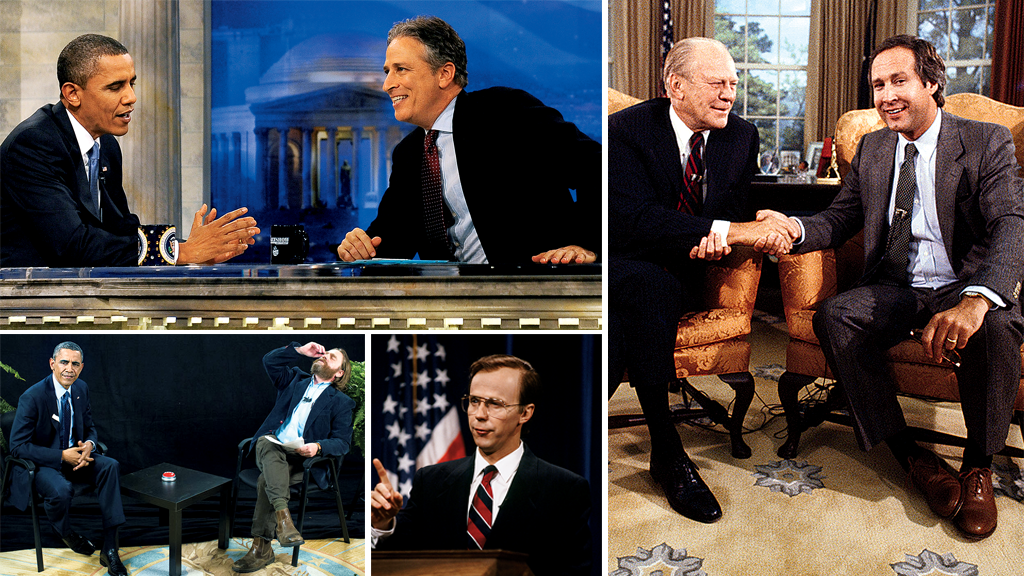When Donald Trump doesn’t show up at the White House Correspondents’ dinner on April 29, he’ll be the first President in 36 years to skip the shindig. After eight years of chummy repartee between President Obama and a rotating host of professional roasters, Trump’s absence may seem frosty. But a look back at the relationship between the Oval Office and comedians reminds us that he’s not the first unwilling target to sit behind the Resolute desk—and shows how the nature of presidential skewering evolved right along with the country.
1916
It’s likely Woodrow Wilson and Will Rogers were the first President and comedian to have a close relationship (though Rogers knew Teddy Roosevelt and FDR and stayed over at the Calvin Coolidge White House). Wilson loved the theater and, after taking in a Baltimore performance, told Rogers and the other performers: “I am in need of fellows like you.” Later, he used some of Rogers’s lines from the presidential podium.

1922
Rogers took a few shots at the thin-skinned Warren Harding, who refused to attend a show when he learned Rogers planned to make fun of his golf game. In mocking Presidents, Rogers contributed to the humanizing of the Oval Office. He also said of Harding: “There was more of the real ‘everyday man’ in him” than any other President.

1927
Can the right zinger move policy? After the Great Mississippi Flood left parts of the South under 30 feet of water, Rogers joked that limited-government hawk Coolidge had been slow to respond to the calamity out of a “hope that those needing relief will perhaps have conveniently died in the meantime.” In reaction to public pressure, Coolidge sent Secretary of Commerce Herbert Hoover to the Gulf, making him the first “disaster czar” in our nation’s history.

1954
What Rogers was to radio, Phil Silvers was to television. He owed his career in part to a TV and Radio Correspondents’ Dinner performance where, after taking in the distinguished audience, he asked Dwight Eisenhower:“My goodness, who’s minding the store?” The audience roared, including CBS exec Hubbell Robinson Jr., who offered Silvers a show.

1975
It wasn’t always so sunny between political comics and their subjects—Richard Nixon saw some comedians as the enemy. He was so exercised about talk-show host Dick Cavett that he asked chief of staff H.R. Haldeman, “Well, is there any way we could screw him? That’s what I mean. There must be ways.” Haldeman’s disturbing response: “We’ve been trying to.”

1975
Cut to the Saturday Night Live era. Chevy Chase’s imitation of Gerald Ford stumbling around the White House cemented a perception of Ford as a dimwitted lummox. Ford, who was a football star at the University of Michigan, may have been the best athlete ever to serve as President, but, as Mark Leibovich later wrote in the New York Times, “No one did more to solidify Mr. Ford’s unfortunate, and perhaps unfair, standing as the nation’s First Klutz than Mr. Chase.”

1992
Dana Carvey’s pitch-perfect imitation of George H.W. Bush’s meandering diction was a big hit on SNL and with the President himself. Bush even invited Carvey to entertain staff at the ’92 White House Christmas party, where he thanked the comic “for brightening our lives, giving us a little joy.”

2008–16
Undoubtedly, some Presidents get lighter treatment than others. Jon Stewart cracked that Obama visited the West Bank so he could see “the manger [in] Bethlehem where he was born.” Obama was close to a number of big comedians. He promoted his Affordable Care Act on Zach Galifianakis’s Between Two Ferns and was the first President to appear on late-night shows while in office.
This article appears in the April 2017 issue of Washingtonian.


















